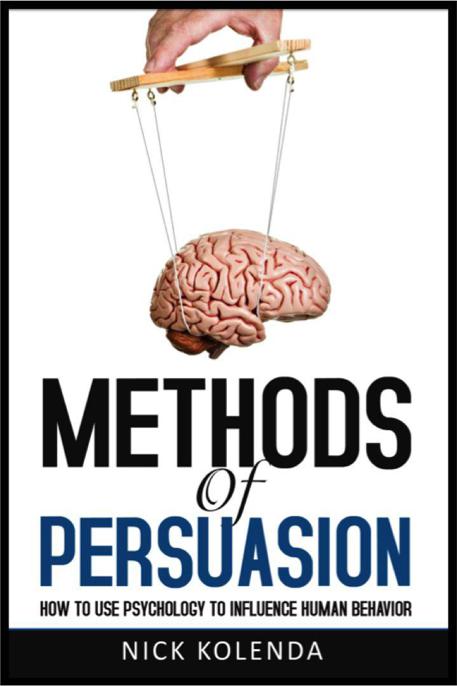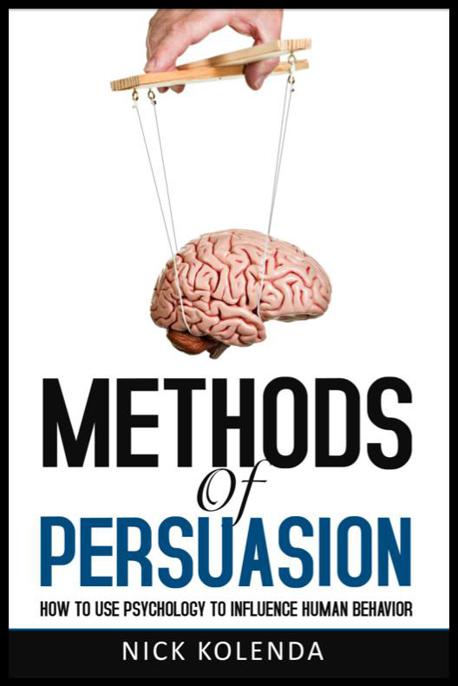Methods of Persuasion: How to Use Psychology to Influence Human Behavior
Read Methods of Persuasion: How to Use Psychology to Influence Human Behavior Online
Authors: Nick Kolenda
Tags: #human behavior, #psychology, #marketing, #influence, #self help, #consumer behavior, #advertising, #persuasion



Methods of Persuasion: How to Use Psychology to Influence Human Behavior
Copyright 2013 © Kolenda Entertainment, LLC
www.NickKolenda.com
ISBN: 0615815650
ISBN-13: 9780615815657
All rights reserved. No part of this publication may be reproduced or distributed in any form or by any means, or stored in a database or retrieval system, without the prior written permission of the publisher.
Table of Contents
Chapter 1: Prime Their Mindset
Chapter 2: Anchor Their Perception
Chapter 3: Convey High Expectations
Step 2: Elicit Congruent Attitudes
Chapter 4: Control Body Language
Chapter 5: Create Behavioral Consistency
Step 3: Trigger Social Pressure
Chapter 6: Emphasize Social Norms
Chapter 7: Reveal Any Similarities
Step 4: Habituate Your Message
Chapter 8: Use Repeated Exposures
Chapter 9: Desensitize Negative Messages
Chapter 10: Alter Their Evaluation
Chapter 11: Tweak Your Message
Chapter 12: Provide Proper Incentives
Chapter 13: Motivate Through Limitations
Step 7: Sustain Their Compliance
Chapter 14: Make Favorable Associations
Acknowledgments
Researchers are somewhat unlucky. Many work their butts off to expand our knowledge of human behavior, yet the majority of those researchers remain unknown and unrecognized.
Though they’re under tremendous pressure to “publish or perish,” researchers are pressured to publish their work in top-level academic journals (journals that you’ll be hard-pressed to find in any mainstream household). In fact, researchers who publish their work in a book for the general public are sometimes viewed as a “sellout,” so it seems like many researchers are destined to remain unknown because of those unfortunate circumstances.
Accordingly, I’d like to acknowledge all of the researchers who
are
helping to further our understanding of human behavior. In particular, I want to acknowledge the researchers whose work sparked my own interest in this pursuit: Robert Cialdini, Daniel Kahneman, Dan Ariely, John Bargh, Gavan Fitzsimons, Richard Petty, John Cacioppo, Leon Festinger, Ap Dijskterhuis, and the list goes on. Your work is truly revolutionary, and you deserve the utmost recognition and praise.
Preface
Let me guess. You skipped over the Acknowledgments and came directly to the Preface, right? Most people do. If you
are
among that majority, go back and read the Acknowledgments, and then come back here.
Are you back? Great. My name is Nick Kolenda, and I’ve been a professional mind reader for 10 years. Do I have supernatural powers? Nope. Just a pretty good knack at reading people and influencing their thoughts.
As a mind reader, I’ve structured my entire performance around the concept of psychological influence, and over the course of 10 years, I developed a unique method to unconsciously influence people’s thoughts. Where does the “mind reading” come into play? Because those people are unaware that I influenced their thoughts, I can reveal the thought that I implanted and, essentially, “read their mind.” I’ve always kept my method hidden, but this book finally reveals that explanation (and the psychology behind why it works).
But this book stems far beyond that one mind reading application. Not only will
Methods of Persuasion
teach you how to influence people’s thoughts, but it will also teach you how to use psychology to control their behavior. In addition to my unique background as a mind reader, I also have an educational background in persuasion through my degrees in marketing and psychology. While in college, I became obsessed with finding the psychological forces that guide human behavior, and although most people can barely make it through one scholarly article, I sifted through hundreds—if not thousands—of academic journal articles, trying to pinpoint proven principles that guide our behavior.
In my pursuit, I discovered several psychological forces that exert an incredibly powerful influence on our behavior. These principles are so pervasive and ingrained within us that they guide our behavior every day without our conscious awareness. More importantly, if you know how to alter those forces, you can use them to guide people’s behavior.
This book will teach you those principles and more.
Best wishes,
Nick Kolenda
October, 2013
Introduction
Humans are marionettes. Attached to each of us are sets of strings that, when pulled in a certain direction, guide our behavior without our awareness. If you know how to control the strings, then you know how to control behavior. This book teaches you how to control those strings.
This book will teach you how to successfully (and ethically) become a puppeteer in a world full of human marionettes.
Because of my peculiar background as a mind reader and psychology researcher, the book that you’re holding is pretty unique. But there’s one particular distinction that makes it especially different from other books on persuasion. Most persuasion books simply list an arsenal of tactics that you can use at your disposal; however, the persuasion methods in this book have been strategically arranged into a chronological seven-step process. If you need to persuade someone to perform a specific task, you can follow the exact steps described in this book to achieve your goal. Although you can still pick and choose the persuasion tactics that you want to implement, this step-by-step guide will get you headed in the right direction.
Conveniently, this step-by-step persuasion process follows the acronym METHODS (do you get the book title’s double entendre?). The overall steps in METHODS include:
- Step 1: Mold Their Perception
- Step 2: Elicit Congruent Attitudes
- Step 3: Trigger Social Pressure
- Step 4: Habituate Your Message
- Step 5: Optimize Your Message
- Step 6: Drive Their Momentum
- Step 7: Sustain Their Compliance
It might seem like a simple list, but the amount of psychology literature that I scoured to produce that list is mind-numbing (feel free to take a gander at the list of references at the end of the book).
Part of my goal in writing this book was to make it the book in your collection with the most highlighting. You won’t find any long-winded explanations, irrelevant anecdotes, or any other type of “fluff” because I’ve tried to make everything as direct and straight to the point as possible (while still making the book interesting and engaging to read).
Last-Minute Background Info.
Before jumping straight to the first step in METHODS, there’s some last-minute background information that can help you gain the most from reading this book.
Persuasion Is Not Manipulation
. The term “manipulation” generally refers to a malicious attempt to influence another person through questionable or blatantly unethical tactics (e.g., lying and deceit). The term “persuasion” is sometimes grouped with “manipulation,” which is very unfortunate because the two terms represent very different ideas.
The tactics in this book are neither ethical nor unethical;
how you use these tactics
will determine that outcome. Although it’s not my job to “persuade” you to adopt a moral outlook, I wholeheartedly oppose anyone who tries to use these tactics to manipulate people. The principles in this book can be very powerful, and I urge everyone to use them with proper care and concern for other people. You should never try to persuade people to perform actions if you know that those actions are not in their best interest.
Definitions
. In this book, I’ll use the term “target” when referring to the person(s) that you’re trying to persuade. For example, if you’re trying to persuade a coworker to write you a recommendation, your coworker would be your “target” (you should also note that I will randomly alternate between using “he” and “she” pronouns when referring to a hypothetical person).
I’ll also use the term “request” when you’re trying to persuade someone to perform a specific behavior (e.g., to write a recommendation), and I’ll use the term “message” when referring to the medium that you use for persuasion (e.g., an e-mail to your coworker). But both terms will be used more or less interchangeably.
Lastly, most of the techniques in this book exert a “nonconscious” influence, meaning that people will be unaware that those principles are guiding their behavior. In writing this book, I chose to use the word “nonconscious” because the terms “subconscious” and “unconscious” have a connotation that there’s some part of our brain responsible for unconscious processes (which isn’t the case). The term “nonconscious” seems more accurate because it makes no such claim; it just refers to everything that occurs outside of our awareness.
Structure of Chapters
. The book is divided into seven parts, with each part representing a step in the METHODS process. Each of those seven parts will contain several chapters that explain a relevant psychological principle that you can use to accomplish the overarching step.
Every chapter in this book shares a similar structure. I’ll first describe the background of the principle and how it exerts its influence in our daily lives. Next, I’ll describe the psychology research to explain why that principle is so powerful. Lastly, each chapter will end with various example strategies to apply that principle toward persuasion.
If I’m so committed to being clear and concise, why am I bothering to teach the underlying psychology? Why not focus solely on the applications? There are two main reasons. First, by citing the research to support the principle, I’m hoping that you can gain an appreciation for the effectiveness of each application. Second, and more importantly, in order to take full advantage of the
how,
you need to understand the
why
. Once you understand the underlying psychology, you can start to move beyond the example techniques that I describe, and you can start to brainstorm your own persuasion applications and strategies. It’s like the Chinese proverb: Give a man a fish and you feed him for a day; teach a man to fish and you feed him for a lifetime.
STEP 1
Mold Their Perception

